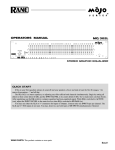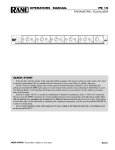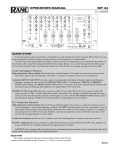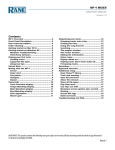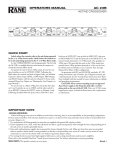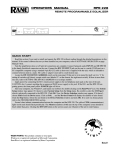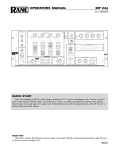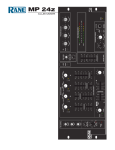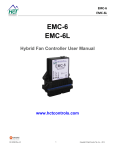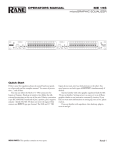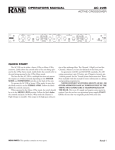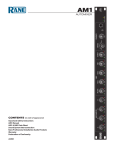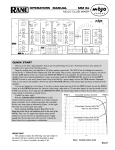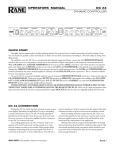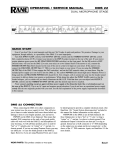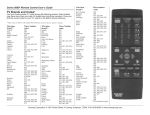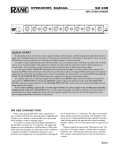Download user manual - Warehouse Sound Systems
Transcript
OPERATORS MANUAL MP 2016 ROTARY DJ MIXER QUICK START The MP 2016 is not a UREI! The MP 2016 has many features absent in the UREI. To fully realize all of the benefits provided by these additional features, please read the entire manual. For those of you who should read the manual, but won’t, here’s the short version. There are four dedicated phono preamplifiers. One each for Input Channels 1-4. Switches on the rear panel set each preamplifier for LINE or PHONO operation. Make sure you have these switches set correctly for your application. There are two dedicated MIC preamplifiers, one each for Input Channels 5-6. Rear panel switches set each preamplifier for LINE or MIC operation. Make sure you have these switches set correctly. MIC GAIN controls adjust each preamplifier for the correct sensitivity. With a MIC selected and ENGAGED, set the INPUT GAIN control to “10” and adjust MIC GAIN to just keep the Input Channel SIG/OL indicator green, not red. Set the tone controls as desired. The MIC ENGAGE switch ducks the BOOTH Output by 12 dB unless defeated with internal jumpers. All five stereo AUX Inputs are available for each of the six Input Channels. Adjust INPUT GAIN controls so they blink the green SIG/OL indicator. If an indicator stays red, the INPUT GAIN control is set too high. This provides optimum signal to noise, dynamic range and MIX LEVEL control consistency. The BOOTH may select CUE or MASTER as its source. CUE allows monitoring Inputs in the booth without headphones. The XP 2016 switch engages the optional XP 2016 processor. If the XP 2016 is not connected, the switch has no effect. See page Manual-7 for XP 2016 features. The EFFECTS LOOP switch switches the Loop in (up) or out (down). If nothing is connected to the EFFECTS LOOP RETURN, the switch has no effect. The MASTER MONO/STEREO switch influences both BOOTH and HOUSE OUTPUTS. It does not affect the EFFECTS LOOP or TAPE OUTPUTS. Two TAPE OUTPUTS are provided. One is PRE-EFFECTS Loop and one is POST-EFFECTS Loop. The POSTEFFECTS Loop Tape Output has a LEVEL control and may be used as a pre-tone control AUX Output. The MP 2016 uses high performance tone control circuits that isolate the signal into three bands. The level of each band is independently controlled, and then recombined. This topology provides full “kill” for TREBLE, MID and BASS. The MASTER SIG/OL indicator monitors the master mix before and after the tone controls. This indicator should light green most of the time. It is OK for it to flash red on occasion. This provides optimum signal-to-noise and dynamic range. HOUSE and BOOTH level controls do not affect the MASTER SIG/OL indicator. The HOUSE OUTPUT has both BALANCED and UNBALANCED Outputs. Always use the BALANCED Outputs for longer cable runs (typically greater than 10 feet, or 3 meters). Headphone cueing allows monitoring MASTER or CUE SOURCE. If MIX LEVEL controls are operated at less than “7”, be sure to turn the PHONES LEVEL down before selecting CUE SOURCE as it may be much louder than the Master Mix. The Headphone Output is low-impedance high-current, so do not short the tip and ring together or to ground. Never connect anything except an approved Rane power supply to the red thing that looks like a telephone jack on the rear of the unit. This is an AC input and requires special attention if you do not have a power supply exactly like the one originally packed with your unit. See the full explanation of the power supply requirements elsewhere in this manual. WEAR PART The MP 2016 contains no wear parts. The XP 2016 contains the following wear part subject to the ninety (90) day warranty period described on page Service-1: (1) Active Crossover Assembly F 60. Manual-1 MP 2016 FRONT PANEL CONTROLS INPUT SELECTORS 1-4 Each six-position Input Selector chooses a dedicated PHONO/LINE preamplifier, or one of five stereo AUX Inputs as its Input Channel source. (PHONO/LINE switches are located on the rear panel). INPUT SELECTORS 5-6 Each six-position Input Selector chooses a dedicated mono MIC Input, or one of five stereo AUX Inputs as its Input Channel source. (MIC GAIN trim, MIC/LINE switch and MIC tone controls are located on the rear panel). MIC ENGAGE MIC 1 and MIC 2 ENGAGE switches allow switching a mic on (up) or off (down). MIC Input must be selected and MIC ENGAGE on to activate a MIC Input. When a mic is not in use, be sure to switch MIC ENGAGE off. The MIC ENGAGE switches also activate the Booth Ducker. This attenuates the Booth Output -12 dB whenever a MIC ENGAGE switch is on, even if MIC Input is not selected (internal jumpers allow disabling the Booth Ducker—see Mic/Line Inputs on page Manual-6). INPUT GAIN INPUT GAIN controls allow the user to match input levels. Adjust these controls to make the SIG/OL indicator flash green. If the indicators turn red, reduce the INPUT GAIN. Adjusting the INPUT LEVEL controls correctly maximizes dynamic range and provides consistent MIX LEVEL response. Input SIG/OL These dual color indicators provide help in setting correct input levels. A flashing green indication is optimal. The red indicator should remain off during normal operation. Manual-2 MIX LEVEL These studio-grade controls determine the Master MIX LEVEL. For optimum performance, set the INPUT GAIN controls as indicated above, and then operate MIX LEVELS between “7” and “10” for full mix. Use the HOUSE and BOOTH LEVEL controls to set the output levels. Always set the MIX LEVEL controls to minimum when not in use. MASTER HOUSE Level This studio-grade control sets the HOUSE Output level. MASTER SIG/OL indicator This dual color indicator helps set correct MASTER mix levels. A flashing or steady green indication is optimal. The red indicator may flash only briefly on rare occasion...regular flashing or steady-on means that distortion is imminent and Levels need reducing. MASTER BOOTH Level This studio-grade control sets the BOOTH Output level. BOOTH CUE/MASTER switch The BOOTH CUE/MASTER switch selects MASTER mix or CUE selection as its source. This allows CUE monitoring in the BOOTH without headphones. PHONES SOURCE selector The PHONES SOURCE selector determines the CUE source to be monitored by the headphones (or the BOOTH if CUE is selected as its source). PHONES CUE/MASTER switch The PHONES CUE/MASTER switch determines if the MASTER or CUE selection is monitored by the headphones. This switch does not affect the BOOTH source. PHONES LEVEL This studio-grade control determines the headphone output level. If you are mixing with the MIX LEVEL controls below “7”, be sure to turn the PHONES LEVEL down before selecting CUE source as it may be much louder than the Master Mix. PHONES jack Plug your headphones in here. The headphone output is very low impedance and high current so do not short tip and ring together or tie to ground, as is common with many lowcost mono cups. Use resistors of 300 to 600 ohms in series with each output for mono applications, although this significantly reduces output power. XP 2016 switch This engages the optional XP 2016 external processor. If the XP 2016 is not connected, the switch does nothing. If an XP 2016 is connected and the switch is on (up), it routes the MIX LEVEL Outputs to the XP 2016 and returns a stereo MASTER signal to the MP 2016. EFFECTS LOOP switch This engages the EFFECTS LOOP when up. If nothing is connected to the EFFECTS LOOP RETURN, the switch has no effect. MONO/STEREO switch This sets the MASTER mix signal to MONO or STEREO operation. It effects both BOOTH and HOUSE Outputs. TREBLE tone control Allows adjusting the amplitude of frequencies above 4 kHz from +10 dB to OFF (full kill). MID tone control Allows adjusting the amplitude of frequencies between 300 Hz and 4 kHz from +10 dB to OFF (full kill). BASS tone control Allows adjusting the amplitude of frequencies below 300 Hz from +10 dB to OFF (full kill). PWR indicator This yellow indicator lights whenever AC power is connected to the unit. Manual-3 REAR PANEL INPUTS & OUTPUTS MIC 1, MIC 2 XLR jacks The MIC 1 Input provides a dedicated balanced preamplifier for Input Channel 5, while MIC 2 provides the preamplifier for Input Channels 6. Each may operate in MIC or LINE mode. Each of these preamplifiers features GAIN trim with BASS and TREBLE tone controls. MIC/LINE switches These select MIC or LINE mode for the MIC Inputs. In MIC mode, the gain range is 20 to 50 dB. In LINE mode, the gain range is 0 to 30 dB. In addition to setting the proper gain range for MIC or LINE level Inputs, these switches also select the proper Input impedance. INPUTS 1-4 RCA jacks INPUTS 1-4 provide dedicated preamplifiers for Input Channels 1-4 respectively. Each may operate in RIAA PHONO or LINE mode. PHONO/LINE switches These switches set Input Channel preamplifiers 1-4 for PHONO or LINE mode. Make certain these switches are set correctly for your source. PHONO GROUND These lugs are provided to connect ground wires from turntables. When using a turntable, proper grounding is essential. MIC GAIN trim These controls adjust the preamplifier for optimum dynamic range. Each has a range of 30 dB, allowing a wide range of sources to be used. To properly set this control, set the associated front panel INPUT GAIN to “10”, turn the MIC ENGAGE switch on and adjust the MIC GAIN so that the input SIG/OL indicator flashes red only during very loud peaks. The front panel INPUT GAIN control can then be adjusted as required according to the instruction outlined above under INPUT GAIN control. MIC TREBLE and BASS controls Separate TREBLE and BASS tone controls are provided for each MIC preamplifier. These allow adjustment of the tonal response of each Mic or Line source at the MIC Inputs. If you add a significant amount of boost, you may need to readjust the rear panel GAIN trims as outlined before. Manual-4 IMPORTANT NOTE CHASSIS GROUNDING If after hooking up your system it exhibits excessive hum or buzzing, there is an incompatibility in the grounding configuration between units somewhere. If your equipment is in a rack, verify that all chassis are tied to a good earth ground, either through the line cord grounding pin or the rack screws to another grounded chassis. This unit’s outboard power supply does not ground the chassis through the line cord. Make sure that the unit is grounded either to another chassis which is earth grounded, or directly to the grounding screw on an AC outlet cover by means of a wire connected to a screw on the chassis with a star washer to guarantee proper contact. Please refer to RaneNote “Sound System Interconnection” (supplied with this manual and available on request at no charge separately) for further information on system grounding. EFFECTS LOOP SEND ¼" jacks SEND Outputs are unbalanced standard ¼" tip-sleeve jacks. They provide a line level Output for external signal processing or effects units. If effects are not being used, these outputs may be used as Auxiliary Outputs. EFFECTS LOOP RETURN ¼" jacks RETURN Inputs are unbalanced standard ¼" tip-sleeve jacks. They provide the Input from external signal processing or effects units. Switching jacks are used so there is no loss of signal if the front panel EFFECTS LOOP switch is active with no effects connected. RETURN Inputs are not appropriate for Auxiliary Inputs as this signal is only selected when the front panel EFFECTS LOOP switch is active, at which time Master signal is derived only by the signal present at the RETURN Inputs, the mix signals are disconnected. BOOTH OUTPUT RCA jacks The unbalanced stereo BOOTH OUTPUT is normally used for booth monitoring. As previously outlined, very flexible source selection is provided as well as MIC ducking. Remember, the BOOTH OUTPUT is attenuated by 12 dB whenever one of the front panel MIC ENGAGE switches is active (unless ducking has been defeated with the internal jumper. See Mic/Line Inputs on page Manual-6). HOUSE OUTPUT jacks Both balanced (XLR) and unbalanced (RCA) jacks are provided. For long runs, we highly recommend using the BALANCED outputs. The UNBALANCED outputs are intended for short runs of less than 10 feet (3 meters). Both may be used simultaneously if required. AUX INPUTS 1-5 RCA jacks These five stereo AUX Inputs are unbalanced, line level Inputs available for selection on all six Input Channels. XP 2016 EXTERNAL PROCESSOR The XP 2016 port provides the required socket for connecting the XP 2016 ribbon cable (supplied with the optional XP 2016). If an XP 2016 is not connected, the front panel XP 2016 engage switch has no effect. If ribbons longer than that supplied with the XP 2016 are used, crosstalk may increase and immunity to RF, magnetic and conducted interference may be compromised. Don’t do it. TAPE OUTPUT – PRE-EFFECTS RCA jacks This unbalanced line-level Output is located before the EFFECTS LOOP and tone controls for recording the Master Mix. MIC Inputs are mixed as any other source and will be present at both TAPE OUTPUTS. TAPE OUTPUT – POST-EFFECTS RCA jacks This unbalanced line-level Output is located after the EFFECTS LOOP and before the tone controls. This may be used as an Auxiliary Output. For this application, as well as for more flexibility when recording, a LEVEL control has been provided as described below. TAPE OUTPUT – POST-EFFECTS LEVEL control This adjusts the POST-EFFECTS TAPE OUTPUT from unity gain to off, allowing optimum sensitivity adjustment for recording or for an Auxiliary Output. POWER jack The power jack receives the cable from the RS 1 power supply shipped with the unit. The chassis ground screw located just above the jack is intended for earth grounding the chassis. (see Chassis Grounding note.) Manual-5 OPERATION RIAA PHONO/LINE INPUTS Input Channels 1 through 4 each have a dedicated preamplifier. A switch on the rear panel allows setting these preamps for PHONO or LINE level signals. Make sure you have the switch in the correct position for your application. The source selectors for Input Channels 1 through 4 may select the dedicated PHONO/LINE preamplifier or one of the five stereo AUX Inputs as the source. With normal program material playing, set the INPUT GAIN trim to a level that causes the SIG/OL indicator to flash green. The SIG/OL indicator should not flash red. This will ensure optimum signal to noise ratio and dynamic range. If INPUT GAIN controls are set too high, you may not have the required headroom for mixing multiple Inputs. If your levels are set too low, signal-to-noise ratio is compromised. In addition to optimizing noise and dynamic range, properly setting the INPUT GAIN control allows the MIX LEVEL control to operate predictably over its entire range. The taper of the MIX LEVEL control is non-linear and will have different attenuation verses rotation characteristics depending on its position. As can be seen in Figure 1 below, if you are mixing between 30% and 60% of rotation, the MIX LEVEL control will behave much differently than if operated between 65% and 95% of rotation. 0L[/HY HO7DSHU 5RWDWLRQ QR WLD XQ WHW $ MIC/LINE INPUTS Input Channels 5 and 6 each have dedicated preamplifiers. A switch on the rear panel allows setting these Inputs for MIC or LINE level signals. Make sure you have the switch in the correct position for your application. While these Inputs are designed for use with dynamic microphones (no phantom power) or wireless microphones with line level output, they will accept just about any mono signal. While balanced operation is highly recommended, these Inputs may be operated unbalanced with sources that are close to the MP 2016 (less than 10 feet or 3 meters). The source selectors for Input Channels 5 and 6 may select the dedicated MIC/LINE preamplifier or one of the five stereo AUX inputs as its source. Manual-6 Prior to permanent installation, adjust the preamplifier GAIN, BASS and TREBLE controls (located on the rear panel) for the intended source. In addition to the MIC/LINE switch, each preamplifier has a MIC GAIN control located on the rear panel. To properly set the MIC GAIN control, set the INPUT GAIN control on the front panel to “10.” This allows the INPUT GAIN SIG/ OL indicator to accurately indicate the signal level. Adjust the MIC GAIN so that the red OL indicator just stays off during high signal peaks (if a microphone is in use, yell into it). The MIC GAIN control should only have to be set once for the source in use. Use the front panel INPUT GAIN control for trimming the gain after installation. Next adjust MIC 1 and/or MIC 2 BASS and TREBLE controls (on the rear panel) to give the desired tonal quality. If you add a lot of BASS or TREBLE boost, you may want to readjust the MIC GAIN control to avoid possible overloading. Note that MIC 1 and MIC 2 each have an ENGAGE switch to the right of the Input Selector. For a mic signal to be active, the selector must be set to MIC and the MIC ENGAGE switch set to ENGAGE (up). When either of the ENGAGE switches is set to the ENGAGE position, the BOOTH OUTPUT is ducked (attenuated) by 12 dB (about ¼th ). If you do not want the BOOTH OUTPUT to duck when a MIC source is engaged, then you can remove the top cover and set the internal jumper accordingly. There is an independent Ducker select jumper for MIC 1 and MIC 2. It sounds like a lot of trouble to set the input stages up correctly, however, you will be amazed at how much better your performance sounds. MIX LEVEL With the Input stages properly adjusted, you are free to use the MIX LEVEL control for mixing. For most applications, Channels will be mixed at about 70% to 100% rotation. BOOTH and HOUSE level controls are then used to set the output volume. The MASTER SIG/OL indicator displays the signal level of the mix. The GREEN SIG indicator should flash or remain on. The RED OL indicator should remain off (it may flash occasionally). To correct an overload condition, one or more of the MIX LEVEL controls must be turned down. The MASTER SIG/OL indicator monitors the signal before and after the tone control, so if you use a lot of boost, remember to monitor this indicator. TONE CONTROLS The MP 2016 uses high performance tone control circuits that isolate the signal into three bands. The level of each band is independently controlled, and then recombined. This topology provides full “kill” for TREBLE, MID and BASS. If all three bands are set to the same level, there will be no change in frequency response, only amplitude. It is the difference in settings that determines the tonal quality of the signal. These advanced tone controls provide excellent dynamic response with fixed phase shift. Control is smooth and predictable. The tone controls can isolate beats, vocals and “high-hat,” as well as adjust general tonal quality. Remember that the dedicated Mic tone controls (on the rear panel) are used to equalize the Microphone Inputs. OPTIONAL XP 2016 EXTERNAL PROCESSOR Combining the optional XP 2016 EXTERNAL PROCESSOR with the MP 2016 adds three-band, full-cut, Accelerated-Slope™ tone controls and A-POST-B Crossfader Assign switches for each of the six Input Channels, high-performance Active-Crossfader™, with full-range Contour control and a stereo 10-segment peak dBu Master/Cue Meter with peak hold. With these added features, the system accommodates the diverse needs of virtually all DJ mixing styles. The post MIX LEVEL signals from the MP 2016 are routed to the XP 2016, processed by the tone controls, then assigned to the A side of the fader, B side of the fader or post fader. The mixed signal is returned to the MP 2016. If the XP 2016 engage switch is active, the MASTER signal gets the XP 2016 mix. If the XP 2016 engage switch is not active, the MASTER signal gets the normal MP 2016 mix. CHANNEL 1-6 TREBLE Allows adjusting the amplitude of frequencies above 4 kHz from +10 dB to OFF (full kill). CROSSFADER CONTOUR This control allows adjusting the “shape” of the Crossfader response from a gentle curve for smooth, long running fades, to the steep pitch required for top performance cut and scratch effects. (See the graph in the Data Sheet.) PEAK PROGRAM/CUE METER The stereo 10-segment Meter on the XP 2016 monitors the same signal as the headphones. If MASTER is selected as the source, the Meter will indicated the MASTER signal level before the HOUSE and BOOTH level controls. If CUE is selected as the source, the meter will indicate the level of the selected CUE signal. PWR indicator This yellow indicator lights whenever AC power is connected to the unit. CHANNEL 1-6 MID Allows adjusting the amplitude of frequencies between 300 Hz and 4 kHz from +10 dB to OFF (full kill). CHANNEL 1-6 BASS Allows adjusting the amplitude of frequencies below 300 Hz from +10 dB to OFF (full kill). CHANNEL 1-6 A/POST/B assign These switches assign each of the six input channels to the A side of the Crossfader, B side of the Crossfader or POST Crossfader CROSSFADER This implements using Ranes’ proprietary Active Crossfader™ design. All audio is isolated from the control element, greatly extending the life and performance of the control. See page Manual-8 for cleaning and replacement instructions. Manual-7 This is the required socket to connect the XP 2016 to the MP 2016, using the ribbon cable supplied with the XP 2016. If a ribbon longer that that supplied with the XP 2016 is used, crosstalk may increase, and immunity to RF, magnetic and conducted interference may be compromised. So don’t do it! POWER This power jack receives the cable from the RS 1 power supply shipped with the unit. The chassis ground screw located just above the jack is intended for earth grounding the chassis (see Chassis Grounding note on page Manual-4). XP 2016 Ribbon Connections: (PIN 1 marked Ñ) 1) GND 2) GND 3) MIX RIGHT OUT 4) MIX LEFT OUT 5) GND 6) METER LEFT IN 7) METER RIGHT IN 8) GND 9) CH 6R IN 10) CH 6L IN 11) GND 12) CH 5R IN 13) CH 5L IN 14) GND 15) CH 4R IN 16) CH 4L IN 17) GND 18) CH 3R IN 19) CH 3L IN 20) GND 21) CH 2R IN 22) CH 2L IN 23) XP 2016 ENABLE (GND) 24) CH 1R IN 25) CH 1L IN 26) GND Fader Cleaning With heavy use in harsh environments, the faders may need lubrication. This treatment extends longevity and can make used faders as good as new. The fader assembly must be removed from the XP 2016 for proper cleaning. We recommend any of the following cleaning solutions: Caig Cailube MCL 100% spray lubricant Caig Cailube MCL 5% spray cleaner CRC 2-26 Order CaiLube MCL® from: CAIG Laboratories, Inc. 12200 Thatcher Ct. Poway, CA 92064 Phone 858-486-8388 Fax 858-486-8398 Web http://www.caig.com CLEANING INSTRUCTIONS A. Fader assembly removal 1. Remove (2) 3mm screws. 2. Draw fader assembly out through hole. 3. Remove ribbon cable. B. Fader cleaning 1. Hold the fader assembly away from the mixer. 2. Position the fader at mid-travel. 3. Spray cleaner/lubricant into both ends of the fader. 4. Move the fader over its full travel back and forth a few times. 5. Shake excess fluid from the fader assembly. 6. Wipe off excess fluid. ©Rane Corporation 10802 47th Ave. W., Mukilteo WA 98275-5098 TEL (425)355-6000 FAX (425)347-7757 WEB http://www.rane.com Manual-8 103521









